Moondrop Golden Ages
Review updated with Firmware 1.1.0 Measurements and some technical updates
Moondrop’s futuristic love letter to the Sony Walkman
2024 is obviously the year of retro-futurism in audio, FiiO released a ‘real’ walkman clone (but with some modern niceties like a rechargeable battery and a USB-c DAC ), Cambridge Audio released a ‘Back to the Future’ Delorean Amplifier and now Moondrop have released the Golden Ages TWS with some subtle and not so subtle design references to the original Walkman.

Moondrop’s offering is a much more practical one than FiiO’s, the Golden Ages has all the 21st century advanced audio components you should expect with a planar drivers and LDAC as well as conveniences like touch controls and of course ANC to enhance your auditory experience.
Note: I would like to thank Moondrop for providing the Golden Ages for the purposes of this review - if you are interested in more information about the Golden Ages link to the Moondrop Website: [here] (https://moondroplab.com/en/products/golden-ages)
But is it the right TWS for you? Read on to find out …
Retail Box
I love the colourful design of the retail box:

Lots of details on the back are the box, including a preview of the Frequency Response’s you can expect - much more on
this in the measurements section later on:

Moondrop also provide detailed specifications inside the box:

Inside the box you get a nice presentation and an extra protective case:

Build quality and accessories
It comes with a small selection of ‘oval’ shaped eartips, including an extra set of the medium-sized tips
attached to each earbud. So 4 pairs of ear tips in total. Given the Oval shape of the ear tips, I was a little curious
if I would be able to use my normal ear tips with the Golden Ages but even with the oval shape, almost all the
third party ear-tips I tried fitted perfectly except for some large triple flange eartips.
The protective case is a nice extra also, this was one of the things that was badly missed with the Moondrop Space
Travel TWS:

And unlike most TWS charging cases where its impossible to have extra large sized eartips attached while also
charging, I was delighted to see that there was enough space internally to allow much larger alternative ear tips,
so for example, I tried some large comply foam tips though these were a bit of a squeze the box still cloved and the
case was able to charge the earphones:

And even some Spinfit XL ear tips fit:
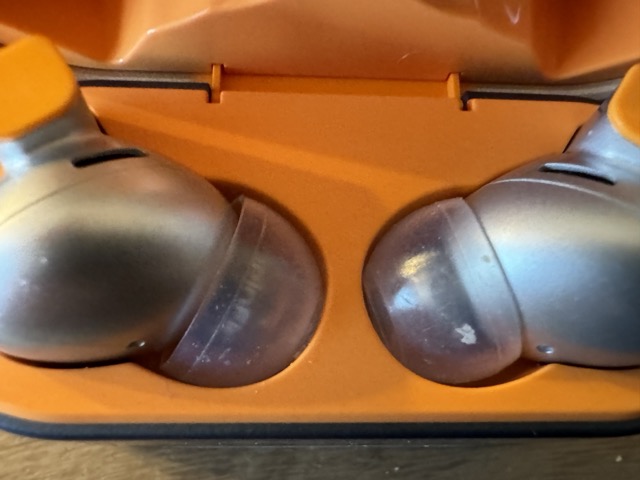
Overall, I thought the build quality was about appropriate for a $79 TWS set. It doesn’t match the quality of a flagship TWS like the Sennheiser Momentum Wireless or even Hifiman Svanar Wireless LE, but I do feel it’s a solid upgrade over cheap TWS sets like the Moondrop previous TWS the ‘Space Travel’ or similar priced Soundcore TWS.
Here is a little video to give you a feel for how the Golden ages looks from all angles:
In Ear Comfort
While I found the largest ear-tip pretty comfortable and gave me a reasonable good seal, I ended up mainly using the even larger XL Spinfit which I found very comfortable and gave me an excellent seal even when out walking.
As far as fit is concerned, my only complaint was the angle of the stalk of each eartip limits the angle that you can put the IEM in your ears, this is why I switched to the Spinfits but might be a problem for some. This was the same minor quibble I had with the comfort with Moondrop’s Space Travel.
Moondrop specifically highlighted that this design suits users with small ear canals, but by switching ear tips it also worked well for my larger ear canal, so I believe depending on your ear canal shape it might be worth trying some other ear tips to get that perfect and secure fit.
I recorded a short video of the eartips, so you can see and hoping judge if the angle is correct for you:
Design Similarities to the Space Travel
The shape of each earbud and eartips are exactly the same size as ‘Space Travel’:
In fact, you can power the Golden Ages buds inside the Space Travel case and vice versa for example:
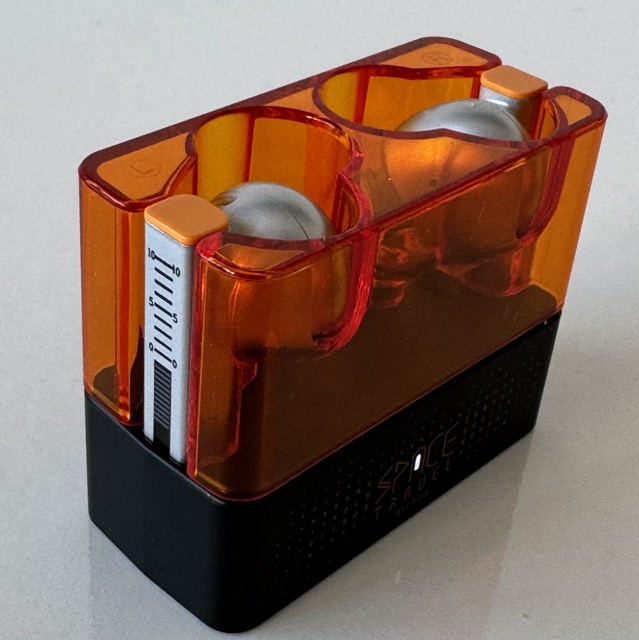
The charging cases themselves have a similar shape with the Golden Ages one slightly bigger:
A key difference and a good upgrade IMO with these cases is that the Golden Ages protects the earbuds when they are in your pocket, the Space Travel box had the tendency to pick up fluff and over time this can stop it charging.
Comparing the specifications, both have similar battery capacities in both the eartips (37 mAh) and the charging box: (380 mAh) though crucially the battery life of the Golden Ears earbuds is rated at 6 hours against the 4 hours for the space travel earbuds. Obviously, this is down to the efficiency of the planar driver and low power 22nm consumption chip used in the Golden Ages.
Skeuomorphic Design of the Charging Case:
The most iconic part of the design of the Golden Ages is the case itself, which has the original Sony Walkman Colour scheme and has a very ‘skeuomorphic’ design featuring a ‘fake window’ showing the reels of the tape:

Also, each ear tip where the touch controls are:
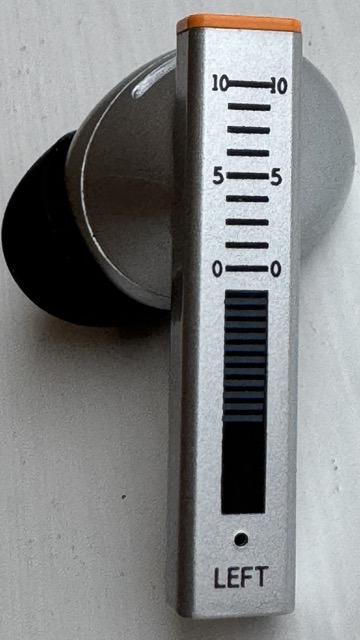
which is cleverly reminiscent of the original volume ‘slider’ on the Sony Walkman from 1979. Here is an old photo for
comparisons:

Note: It is a pity that you can’t slide you finger on the skeuomorphic ‘volume’ slider but the earbud does have touch controls which as you will see can be configured within the Mobile App.
Of course, the irony with the Golden Ages is that it so packed with features and the latest audio technology that it really is 45+ years ahead of that original Sony Walkman.
But Moondrop clearly want this TWS to be a tribute to the ‘first golden age’ of portable audio.
Features:
Given this is a TWS and will compete with the likes of Apple, Bose and Sennheiser, there is a certain expectation for ‘consumer’ friendly features that are expected from a TWS and Moondrop have mostly provided a competitive offering with the features provided here, including touch friendly controls, ANC and transparency modes as well as automatic wearing detection.
But let’s get into the details and see how competitive these features are:
ANC and Transparency modes
Moondrop have tried something a little different as far as ANC is concerned, most ANC implementation alter the sound signature significantly and Moondrop obviously prioritize sound quality over everything, so instead of the typical ‘feedback’ ANC modes that will typical feedback the inverse of the outside noise into the audio signal path Moondrop have implemented a “Single Feedforward” that does not affect or change the frequency response.
So, while I think this worked a little better than the ANC in the “Space Travel” it isn’t quiet as successful as it could be. It worked well on a recent flight and lived up to Moondrop promise in not affecting the sound quality, but when walking around a city center it is not at the level of ‘consumer’ TWS brands like Apple, Bose or Sennheiser.
I hope Moondrop’s next TWS set will also add features like Adaptive ANC and “Wind Reduction” modes, in fact, I think if Moondrop leave this “Single Feedforward” as one of the ANC options e.g. “ANC Max Music Quality” but then also add a way for the user to switch to alternative ANC modes it would be an ideal solution.
Transparency mode though worked well, I suspect that the microphone in the Golden Ages was probably tuned for Transparancy mode support than for microphone quality (i.e. a far field microphone rather than near field), so switching to transparency really pulled in and enhanced outside sounds.
The Golden Ages also has a nice cute little audible “Hey”, “Shh” and “Umm” by “Mitsuki Yuki” when switch ANC modes.
Microphone quality
I was a little disappointed with the microphone quality on the Space Travel, and sadly it is not really any better with the Golden Ages. It was fine in doors when I was on calls in a quiet room, but the microphone obviously lacks some of the more advanced noise cancellation (and wind cancellation) features that TWS from Apple, Bose and Sennheiser now provide as standard. So for example, trying to join a conference call while I was out on a walk, my colleagues found I was breaking up.
Low Latency Game mode
I am not really a gamer, though I tested the Golden Ages Game mode on both my Son’s Gaming Laptop setup where it worked excellently, I notice no ’lag’ in the few games I tried. But I also tried it on his Nintendo Switch where did not appear to lower the latency dramatically. So with the right combination of hardware this will work very well but do not expect it to work with all setups.
This low latency mode is enabled by quickly tapping either earbud 4 times, and you get a little audible message telling you what ‘mode’ you are in “gaming” or “music”. I also briefly tested the latency using the Android “Earbuds latency test” App and I would roughly guess using this that I was getting about 50ms latency with this mode enabled rather than about 100ms in default “music” mode.
Moondrop Link ‘App’ support
I mainly used the Android version of the “Moondrop Link” App, and it is improving all the time. With 2 TWS devices
paired I this ‘home-screen’ within the app:

Clicking on the Golden Ages, it provides good though fairly basic support via 4 tabs. Firstly, the ability to change
the touch settings:
 As I mentioned earlier each ear tip has touch controls, and you can reconfigure these controls in this screen, but
mostly the defaults are sensible.
As I mentioned earlier each ear tip has touch controls, and you can reconfigure these controls in this screen, but
mostly the defaults are sensible.
Then crucially the ability to switch sound ( really ‘bass’ ) profiles:
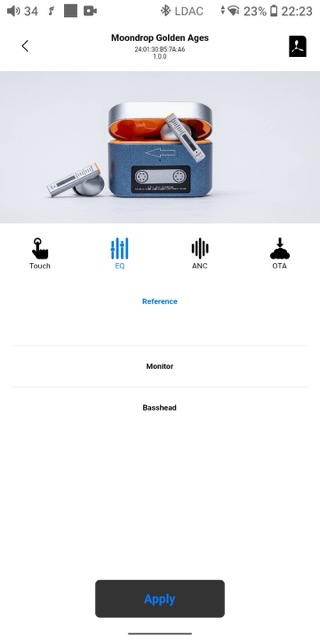
Note: I found it great that you can instantly switch within the Moondrop App to A/B test the different profiles, this makes evaluating the different profiles much easier than even IEM’s with ’tuning’ buttons. But you do need to be listening with your Android phone to switch. It also made measurements much easier as I did not have to ‘move’ the IEM in the coupler to switch ‘profiles’.
Then view and change the ANC modes and configuration:
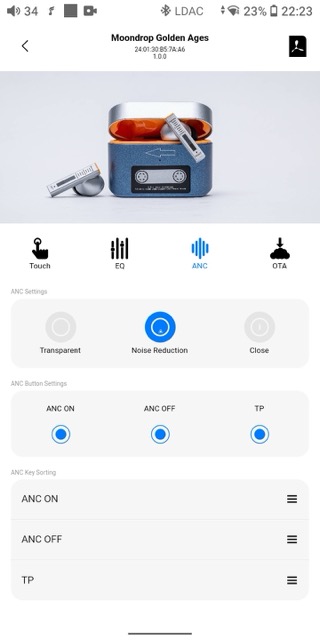
And finally the ability to select and upgrade the firmware:

Note: this is a screenshot from before the 1.1.0 firmware update.
While there is more configuration support in the Moondrop Link App than there is with the Space Travel, I do feel Moondrop could / should enable support for custom PEQ filters (similar to what they support with the FreeDSP and CDSP cables and ‘DSP’ enabled IEM’s like the Chu II DSP). While I like 2 of the 3 provided sound profiles as you will see later in the review I would have preferred a little PEQ tweaking to get even better sound from the Golden Ages.
Sound quality
So lets get into the most important feature and the one which Moondrop really competes with (and even exceeds) those ‘consumer’ flagship TWS, in the quality of the audio.
I found it interesting that the Golden Ages comes with 3 specific bass tunings. I think 2 of these excellent and well named. The Monitor profile (which is a ‘flat’ bass - think ‘studio monitor’ sound) is a great way to hear midrange and treble detail without bass. The Reference tuning (which is the default) add a very nice level of bass to the experience and to my preference was almost the perfect response.
But the third profile, the ‘Basshead’ is in my opinion badly named, though it does have more of a subbass boost but has less mid-bass that the reference which is a strange decision. This might be a profile that Moondrop can change via a future firmware update (but was not changed in 1.1.0 from my measurements). As of firmware 1.1.0 I would not call it “Basshead”. As you can see in the measurement section I compared this “Basshead” with 2 other recent Moondrop IEM’s with “Basshead” and this had considerable less bass than those other “Basshead” profiles.
These listening tests where initially based on the 1.0.0 firmware my Golden Ages came shipped with but while writing this review Moondrop updated the firmware to 1.1.0, so before continuing my listening tests I re-measured to see if there were any changes to the sound. So, I then went back and re-listened to my reference track playlists, but I did not find the new firmware changed the sound.
Bass
This is where the biggest differences between the 3 profiles occur. When I initially started evaluating the sound I
switched between the 3 bass profiles continuously with my key ‘Bass’ playlist tracks. Pretty quickly I realised the
‘Basshead’ was sounded slightly off, so, for example, in tracks like James Blake ‘Limit to your love’ the bass thump
you would expect sounded muted, but later in the sound when the subbass really kicks in it improved dramatically.
But the Reference profile it sounded more consistent with good (though not bass heavy) through that track. Similarly,
with Massive Attack ‘Angel’ which starts with very low subbass then bass frequencies increase over the first 10
seconds of that song, the ‘Basshead’ profile sounded inconsistent, and again with this track the Reference Profile
was my preference.
The ‘Monitor’ profile of course has much less bass presence, it is really about hearing the midrange and treble detail without the bass over powering the mix and to that end it does a great job, but definitely not for ‘Bass heads’.
Midrange
I loved the midrange on Golden Ages, I would go as far as saying it was the best on any TWS I have listened too and right up there what someone should expect for a good $100 wired IEM. The vocals were forward and some of my favourite midrange test tracks from say Elton John both his piano playing and his vocals sounded clear and nice presented. Other tracks like Blackbird on Beyonce’s new ‘Cowboy Carter’ album were outstanding with the various vocals harmonies beautifully forward in the mix.
Treble
Assuming you are on the latest (1.1.0 firmware as I write this review), I think you will find the treble to be excellent, with a nice level of details and sparkle but never getting to that sibilant / fatiquing level of treble. Tracks like ‘Billie Jean’ by Michael Jackson sounded amazing with that ‘80’s treble ‘sheen’ balancing at the right level the excellent bass within that track, and Michael Jackson’s ‘sss’ never sounding sibiliant.
But with the ’technicalities’ to the upper treble were ok but not as outstanding, it rolled off earlier than I would have liked.
Soundstage and Imaging
I found the imaging especially with the good with the reference profile. I did find getting the right seal was crucial, especially when out walking with this TWS. For example, the seal was fine with the large eartips provided when I was sitting in my house, but when I was away on a trip for a few days I did have to swap to a different ‘XL’ eartips to keep that seal and keep a consistent sound. But for the imaging, Binarual tracks like ‘Perfume genius’ ‘Just like Love’ where excellent with a real depth to that track.
The soundstage was good but not great, but I do find getting a wide soundstage with TWS needs some unique tuning, e.g. the Hifiman Wireless Svanar LE has amazing soundstage but at the sacrifice of good tonality.
Specifications:
The specifications of the Golden Ages:
| Spec | Details |
|---|---|
| Bluetooth Version | 5.3 |
| Profiles | A2DP/AVRCP/HFP/HSP |
| Codecs | SBC/AAC/LDAC™/LC3 |
| Charging technology | USB-C |
| Distance | 10m |
| Earphone Charging Time | About 1 Hour |
| Earphone Battery Capacity | 3.7V/37mAh |
| Earphone Life | About 6 Hours(AAC) |
| Case Charging Time | About 1.5 Hours |
| Case Battery Capacity | 3.7V/380mAh |
| Case Battery Life | About 18 Hours(AAC) |
Codecs
LDAC
With LDAC, when it worked with my FiiO DAP ( running Android 10 ) it was fantastic quality but occasionally when I connected it got corrupted and sounded terrible, I would simply disconnect and re-connect and everything would be back to normal. It was unclear was this an issue with the FiiO DAP or the LDAC implementation in the Golden Ages.
Firmware 1.1.0 codec update
So with Firmware 1.1.0 the LDAC codec has been disabled - I imagine Moondrop are fixing some issue and will re-enable it
AAC
With AAC, I was mainly using my Macbook Pro and on my iPhone 15 Pro Max. On Android with my DAP, it was poor compared to LDAC but on my iPhone it actually sounded great - I guess Apple’s implementation of AAC is superior to Android’s. I would guess if I did an A/B blind test between LDAC on Android and AAC on an iPhone I would find it hard to tell the difference.
I didn’t have a device test with LC3 codec yet, but I am due an Android 13 upgrade soon, so I will update the review if I feel it’s the better codec, though I believe it mostly replaces the basic ‘SBC’ codec.
I imagine Moondrop will be investigating some of the newer ‘almost lossless’ codecs like aptX Lossless for future TWS but for now I think both LDAC and AAC is a great solution for the majority of users.
Measurements:
These measurements were taken with a calibrated 711 ‘clone’ coupler
Moondrop proudly show on the back of the box, how neutral the default the sound profile, but let’s get into the details:
Frequency Response
So lets start with the Reference frequency which shows some great channel balance:
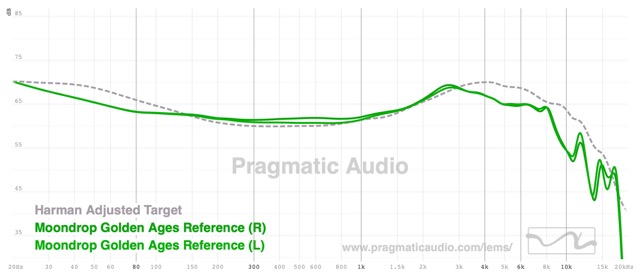
Next, lets compare the 3 different sound profiles that you can switch too via the mobile App:

Firmware 1.1.0 Update: There are currently 2 ’extra’ profiles available ( 5128 and Secret ) with the 1.1.0 update. I decided to measurement them and compare with the 3 profiles that I had been listening too for this review. They seem like EQ experiments to me as they have wildly different from the 3 normal profiles. Subjectively, the 5128 one might be an experiemnt in an alternative ‘basshead’ profile as it does sound very bass heavy.
Here is the graph of the 5 profiles currently in 1.1.0:
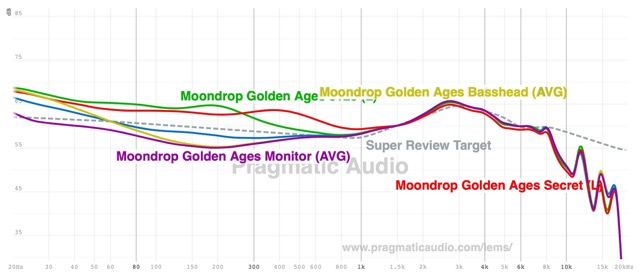
As I mentioned in my subjective sound quality section for me, the ‘default’ Reference is the best sound profile (and the one I mainly used for my listening tests) but the monitor is also pretty good, though lacking a bit of bass. But I do feel the ‘Basshead’ is badly named. I decided to measure some of my other recent Moondrop offerings which also have a ‘Basshead’ option and as you can see in this graph the Golden Ages has the least bass response of these three:

I thought I would also measure the reference with ANC enabled and disabled as well as with Transparency to see
Moondrop ANC lives up to its promise of not affecting the sound signature and as you can see it does:

Distortion
Given it’s a planar driver, it should be no surprise that there is very little distortion:

Note: This was measured at a very high SPL of 96db and even then the distortion is mostly less than 0.2%.
Some Frequency Response comparisons
I also decided to graph the Golden Ages with some TWS alternatives:
 Of these I thought it was interesting to see how the Golden Ages was most neutral of these with the Airpods
Pro and the Hifiman Svanar LE similar except for the extra treble offered by the Hifiman TWS and of course Soundcore
‘Default’ sound profile offering way too much bass and no midrange.
Of these I thought it was interesting to see how the Golden Ages was most neutral of these with the Airpods
Pro and the Hifiman Svanar LE similar except for the extra treble offered by the Hifiman TWS and of course Soundcore
‘Default’ sound profile offering way too much bass and no midrange.
I feel a more valid comparison is actually against great wired IEM’s:

So Kiwi Ears Orchestra Lite is still a personal favourite for its midrange neutral sound, and I had thought a good similar to the Golden Ages and you can see how closely they match but with the Golden Ages having a better subbass but less upper treble.
Note: All these measurements are available here
Comparisons with other TWS
I thought it might be useful for me to give a brief comparison with other TWS sets that I have recently
Space Travel
The Golden Ages is an obvious sonic update over the Space Travel, when switching between these 2 TWS it’s no comparison, the planar in the Golden Ages is (especially with the new firmware) an incredible clear and accurate and especially the ‘Reference’ sound signature is exceptional. The addition of LDAC and the better battery life are 2 other great upgrades, but I do feel that the Space Travel and the Golden Ages share a lot of the same technology as well as sharing the same physical form factor.
Apple Airpods Pro / Apple Airpods Pro 2
This is a totally unfair comparison given the difference in price but for me the Golden Ages has the better more neutral sound profile, though the Airpods Pro 2 does have a better bass response. The Golden Ages also allows use of ’normal’ custom ear-tips of various sizes include XL sized ear tips rather than Apple proprietary eartips. But Airpods especially on IOS (but even on Android) has much better ANC and the microphone support is outstanding.
Soundcore Life P3 / P3i
Soundcore have lots of TWS, so I picked this one as it’s a similar price to the Golden Ages. For sound quality there is no comparison even after ’tuning / taming’ the P3 via EQ via the Soundcore Mobile app, it sounds far inferior to the Golden Ages, but these Soundcore TWS do have better ANC and the microphone ‘array’ that Soundcore have perfected over numerous years is better.
Hifiman Svanar Wireless LE
I feel both Hifiman and Moondrop are both using the audiophile heritage to compete with the more ‘consumer’ orientated
TWS brands and both companies really bought their ‘A’ game to these respective TWS offerings. Hifiman svanar
wireless LE is more than twice the price of the Golden Ages yet sound is the key
Hifiman have a few different ‘Svanar’ TWS offerings but the one I would
compare the Golden Ages with is the $199 LE
edition.
So the Hifiman has a highly technical (though ‘unnatural’) sound signature that is more V-shaped with some excellent tweaks for very wide soundstage, while I found the Golden Ages is much more ‘reference’ sounding with fantastic midrange and better overall imaging. Both have poor ANC compared to those ‘consumer’ brands though the microphone on the Svanar LE was exceptional. If I was to pick one for daily use I would actually pick the Golden Ages due to its sound signature and mobile App support. The Hifiman currently have no Mobile App.
Rating
I gave the Moondrop Golden Ages a pragmatic rating of 4 stars, it has a fun retro design, it supports some excellent sound profiles via the Moondrop Link App, it has some great features like LDAC and has great battery life. But it’s let down a little by the weak ANC and the poor microphone. And I would have loved the ability to further tweak the EQ within the mobile App and I personally would have given the ‘basshead’ profile a difference bass response.
Conclusion
For $79 the Golden Ages is a great sounding True Wireless set, if you prioritize audio quality over everything else then this could easily be the right TWS for you, especially if you like a more neutral reference sound signature, just don’t expect it to match the consumer ‘features’ of flagship True wireless earbuds from the likes of Apple, Bose and Sennheiser.
I do believe sound quality should have the final say in a TWS review and with Planar driver the Golden Ages, Moondrop have provided a TWS that delivers sound quality of top quality.